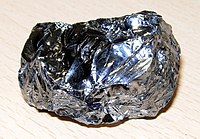
Photo from wikipedia
Two-dimensional transition metal dichalcogenides (TMDCs) are recently emerged electronic systems with various novel properties, such as spin-valley locking, circular dichroism, valley Hall effect, and superconductivity. The reduced dimensionality and large… Click to show full abstract
Two-dimensional transition metal dichalcogenides (TMDCs) are recently emerged electronic systems with various novel properties, such as spin-valley locking, circular dichroism, valley Hall effect, and superconductivity. The reduced dimensionality and large effective masses further produce unconventional many-body interaction effects. Here we reveal strong interaction effects in the conduction band of MoS2 by transport experiment. We study the massive Dirac electron Landau levels (LL) in high-quality MoS2 samples with field-effect mobilities of 24 000 cm2/(V·s) at 1.2 K. We identify the valley-resolved LLs and low-lying polarized LLs using the Lifshitz-Kosevitch formula. By further tracing the LL crossings in the Landau fan diagram, we unambiguously determine the density-dependent valley susceptibility and the interaction enhanced g-factor from 12.7 to 23.6. Near integer ratios of Zeeman-to-cyclotron energies, we discover LL anticrossings due to the formation of quantum Hall Ising ferromagnets, the valley polarizations of which appear to be reversible by tuning the density or an in-plane magnetic field. Our results provide evidence for many-body interaction effects in the conduction band of MoS2 and establish a fertile ground for exploring strongly correlated phenomena of massive Dirac electrons.
Journal Title: Nano letters
Year Published: 2019
Link to full text (if available)
Share on Social Media: Sign Up to like & get
recommendations!